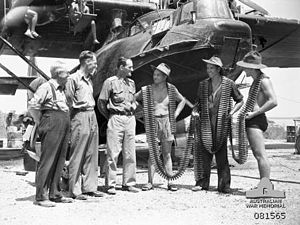- No. 20 Squadron RAAF
-
No. 20 Squadron RAAF 
Members of No. 20 Squadron with lines of machine gun belts wrapped around them speak with members of the parliamentary war expenditure committeeActive 1941–1946 Country  Australia
AustraliaBranch  Royal Australian Air Force
Royal Australian Air ForceRole Maritime patrol; mine laying Engagements World War II Aircraft flown Patrol PBY Catalina (1941–1946)
Short Empire (1941–1942)No. 20 Squadron was a Royal Australian Air Force maritime patrol squadron of World War II. It was formed in 1941 and disbanded in 1946.
History
No. 20 Squadron was established at Port Moresby on 1 August 1941 for a general reconnaissance role. The Squadron conducted long range patrols in conjunction with No. 11 Squadron until the outbreak of war in the Pacific. It then commenced anti-submarine patrols and bombing raids against Japanese bases. As the Japanese advanced into the South West Pacific the Squadron was also responsible for evacuating white civilians from areas threatened by invasion. While the Squadron moved to Bowen, Queensland in May 1942 in response to the increasing frequency of Japanese raids on Port Moresby it continued to conduct reconnaissance, anti-submarine and occasional bombing operations over the waters around New Guinea.
In June 1943, No. 20 Squadron's role changed when it commenced mine laying operations over the Netherlands East Indies and Philippines. In October 1944 the Squadron moved to Darwin so that it could be closer to its area of operations. Three aircraft from No. 20 Squadron flew the RAAF's last mine-laying mission on 30 July 1945.
Following the end of the war, No. 20 Squadron operated in the transport role and ferried Australian prisoners of war home from various locations in South East Asia. The Squadron was disbanded at RAAF Base Rathmines on 27 March 1946.
References
- Steve Eather (1995). Flying Squadrons of the Australian Defence Force. Aerospace Publications.
- RAAF Historical Section (1995). Units of the Royal Australian Air Force. A Concise History. Australian Government Publishing Service, Canberra.
Main series 1 · 2 · 3 · 4 · 5 · 6 · 7 · 8 · 9 · 10 · 11 · 12 · 13 · 14 · 15 · 20 · 21 · 22 · 23 · 24 · 25 · 26 · 27 · 28 · 29 · 30 · 31 · 32 · 33 · 34 · 35 · 36 · 37 · 38 · 40 · 41 · 42 · 43 · 60 · 66 · 67 · 71 · 73 · 75 · 76 · 77 · 78 · 79 · 80 · 82 · 83 · 84 · 85 · 86 · 87 · 92 · 93 · 94 · 99 · 100 · 102 · 107 · 292 · Fighter · Rescue and Communication · Seaplane · Berlin Air Lift
Article XV squadrons Joint Netherlands-Australian squadrons Categories:- RAAF squadrons
- Military units and formations established in 1941
- Military units and formations disestablished in 1946
Wikimedia Foundation. 2010.
